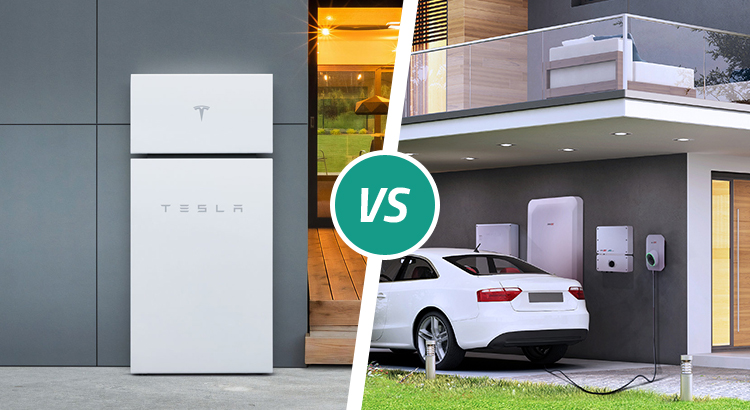Tesla Powerwall vs SolarEdge Home Battery: Which is The Best Choice?

Tesla Powerwall has been the unchallenged market leader in residential battery storage for more than six years. Now, a new competitor has emerged and it promises to give Powerwall a fight for its money.
The SolarEdge Home Battery is that competitor. It is introduced in Australia in March 2022 and is produced by an innovative Israeli solar company with a history dating back to 2006.
We’ll start by checking the quality of both batteries.
Both offer strong safety standards, backup power during grid disruptions, and great power performance.
Although Powerwall is more expensive, it is also a larger battery.
However, the two batteries do differ significantly in a few key ways. And based on these differences, you may choose the battery that is most appropriate for your house.
The differences come down to:
- Whether you already have solar panels installed.
- Where you reside and your network distributor’s rules regarding the size of the solar system that can be installed.
- Whether you plan to fully electrify your home and vehicle(s).
This article has compiled the key differences between the Powerwall and SolarEdge Home Batteries in this post in order for you to make an informed decision about which battery would be best for you.
How to decide whether SolarEdge or Powerwall is best for your home?
When advising clients on whether Powerwall or SolarEdge is the better battery for their house, there are three important questions you should look at.
1. Do you currently have solar panels?
Okay, for many folks, this can be a deal-breaker. If you already have a large solar panel system that is operating flawlessly, you should probably acquire a Powerwall.
That’s because almost any solar panel system that already exists can be used with the Powerwall.
However, SolarEdge doesn’t. SolarEdge Home Batteries are only compatible with SolarEdge inverters.
2. What are the solar system size restrictions imposed by your local network distributor?
The business that owns and maintains the power poles and wires in your neighborhood is known as a network distributor. Additionally, they are the organization that decides whether you are permitted to install solar panels and batteries in your home and the maximum size allowed.
Some network distributors include the battery inverter’s capacity when calculating the total inverter capacity. This means that Powerwall, which has its own battery inverter, will count toward the total permitted inverter capacity if you decide to install it.
As a result, you can go over the maximum inverter size that can be installed on your property and be denied permission to install the Powerwall.
The SolarEdge Home Battery triumphs in this situation.
You can easily get around the majority of network distributor sizing limits because the SolarEdge Home Battery doesn’t have a built-in battery inverter.
3. Do you need the scope for your solar to “grow bigger”?
According to the majority of experts, during the next few years, we should prepare for significant increases in the price of gas and electricity. In some states, the cost of power may increase by up to 20% as of July 1. Those price hikes were planned before the current energy crisis’s explosion. Therefore, it is likely that there will be further price hikes.
The best defense against rising energy costs is to invest in a solar power system large enough to provide the majority of your household’s energy requirements.
But which battery will provide you with more power?
SolarEdge is the solution. This is so that you can put up to 200% more solar panels on your home than the inverter can handle with the SolarEdge Home Battery. For instance, you can install up to 20kW of solar panels if you purchase a 10kW SolarEdge inverter and a SolarEdge Home Battery.
That much solar energy would allow most households to stop using gas and migrate to a solar-powered, entirely electric home and fuel an electric car (or two).
You are only permitted a maximum panel capacity of 133% with Powerwall, which is the standard for all solar panel systems.
It’s also important to note that SolarEdge is panel agnostic, which means you may later install solar panels of any brand or size. As an illustration, you might begin with 10kW of solar panels. You can eventually install more solar panels when you switch to running your home fully on solar energy. It won’t matter if they are 390 watts or 450 watts.
With the help of solar companies providing solar batteries can help you choose the right battery storage for your requirement.
The verdict
Both batteries are better in different scenarios. Therefore, there is no definitive verdict. The batteries Powerwall and SolarEdge are both excellent. It all depends on the requirements of your property.
Our recommendation for your home’s future-proofing is SolarEdge. Anyone who wishes to switch to an entirely electric home that is continuously powered by their own solar energy can achieve excellent levels of expandability with the help of the SolarEdge Home Battery.
However, Powerwall might be a better option if you’ve already made the investment in a sizable solar PV system, perhaps one with 6kW or more. You are buying a tried-and-true battery when you purchase a Tesla Powerwall. Nearly everyone who has a Powerwall will give it a big thumbs up when asked what they think of it.
Tags: solar battery, solaredge, tesla powerwall
